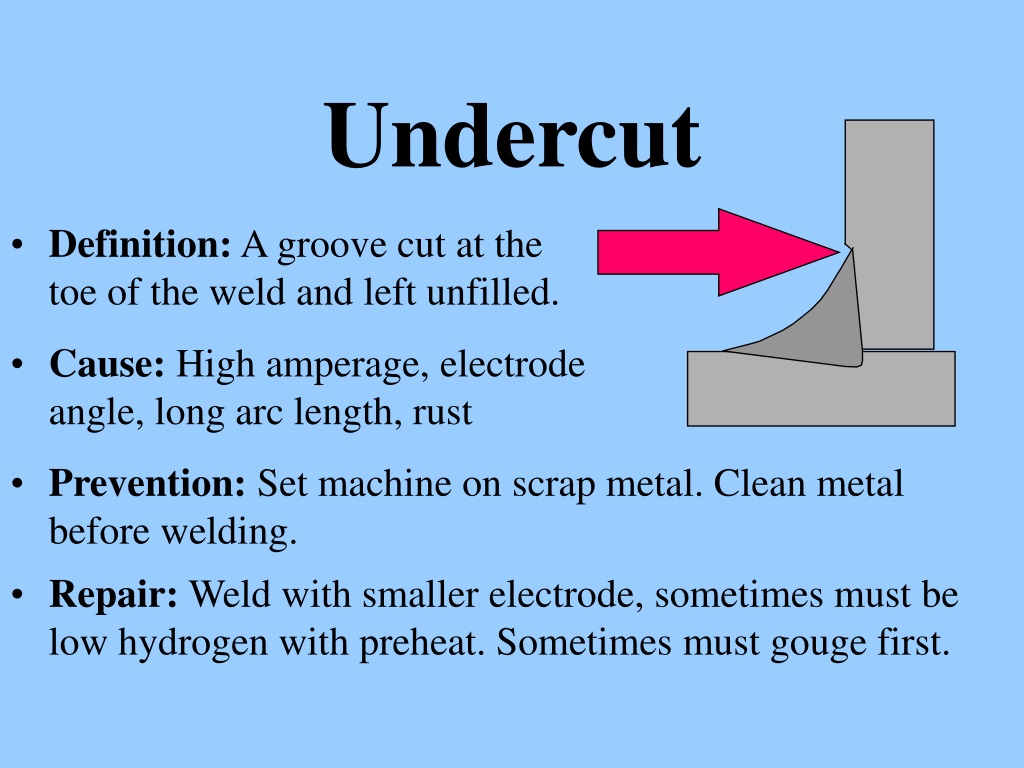Understanding the Causes and Solutions for Undercut Welding in Metal Fabrication Processes
In the realm of steel construction procedures, the incident of undercut welding presents a considerable difficulty that demands a detailed understanding of its causes and practical services. The detailed interaction of numerous aspects during welding operations can lead to this undesirable sensation, influencing the architectural stability and total top quality of the bonded joints - Preventing weld undercut. By exploring the root creates of undercut welding and discovering efficient restorative measures, fabricators can boost the standard of their workmanship and make certain the manufacturing of perfect metal parts
Typical Causes of Undercut Welding
Regularly ignored in metal manufacture, undercut welding happens due to numerous aspects that demand thorough interest and experience to be successfully reduced. One usual source of undercut welding is too much warm input. When the heat input is expensive, it can lead to the melting and succeeding erosion of the base product along the edges of the weld joint, developing a groove or undercut. Additionally, inappropriate welding techniques, such as making use of the incorrect welding angle or travel rate, can likewise add to undercut development. Insufficient securing gas protection is an additional essential variable that can result in damaging. Insufficient gas protection stops working to protect the weld swimming pool sufficiently, bring about oxidation and undercut problems. In addition, the choice of welding specifications, such as voltage, existing, and wire feed rate, plays a significant duty in the occurrence of undercut welding. Understanding these common causes is critical for implementing safety nets and ensuring premium welds in steel manufacture procedures.
Effect of Incorrect Welding Parameters
Unreliable welding criteria can dramatically endanger the stability and top quality of bonded joints in steel construction processes. The impact of incorrect welding parameters shows up in numerous methods, resulting in structural weaknesses and flaws in the welded components. One critical facet impacted by incorrect welding parameters is the infiltration deepness of the weld. Inadequate warm input because of low welding currents or exceedingly high traveling speeds can result in poor combination between the base metals, resulting in insufficient joint penetration and weakened bonds. Conversely, excessive warm input brought on by high welding currents or slow traveling speeds can bring about burn-through and extreme support, producing a brittle and unpredictable weld structure. In addition, inaccurate parameters such as incorrect voltage settings or inaccurate electrode angles can contribute to erratic weld bead accounts, absence of fusion, and boosted chances of issues like undercutting. Consequently, precise focus to welding specifications is extremely important to make sure the production of high-grade welds with the desired mechanical residential or commercial properties and architectural integrity.
Effect of Improper Torch Angle
Inappropriate lantern angle in welding procedures can dramatically impact the high quality and integrity of the last weld joints in steel construction processes. Damaging is a common welding defect where a groove develops along the weld toe, weakening the joint and endangering its structural stability.
A lantern angle that is also steep can cause insufficient infiltration, incomplete fusion, and raised spatter. On the various other hand, a torch angle that is too superficial can lead to excessive infiltration, burn-through, and distortion of the base material. Preventing weld undercut. Proper lantern angle is necessary for making sure consistent weld quality, stamina, and appearance
To avoid damaging and other issues brought on by incorrect torch angles, welders need to be trained to keep the appropriate lantern angle throughout the welding process. Normal tracking and adjustment of lantern angles during welding can aid achieve audio welds with minimal issues.
Function of Inadequate Welding Strategies

One more element of insufficient welding methods is improper weld preparation. Poor cleansing of the base steels, inaccurate joint design, or insufficient edge prep work can all add to undercut welding. Furthermore, inadequate shielding gas insurance coverage or making use of the wrong type of gas can result in insufficient combination and the development of undercut flaws.
To resolve the function of inadequate welding strategies in metal fabrication procedures, it is important to offer comprehensive training for welders. Correct education on welding parameters, joint prep work, and shielding gas option can assist prevent undercut welding and make certain high-grade welds in metal manufacture projects.
Reliable Solutions for Undercut Welding
Dealing with undercut welding in steel construction requires carrying out effective options to enhance weld top quality and structural stability. One of the key services to battle undercut is to adjust welding criteria such as voltage, current, and travel rate to guarantee correct heat input and combination. By fine-tuning these setups, welders can avoid too much melting of the base steel and filler material, lowering the possibility of content undercut development.
In addition, proper joint prep work is crucial in stopping undercut. Making certain clean base metal surface areas free of pollutants and utilizing the appropriate bevel angle can help promote better weld infiltration and lower the risk of undercut - Preventing weld undercut. Utilizing appropriate welding strategies, such as weaving or oscillating the torch, can likewise help in distributing warmth evenly and filling the weld Read Full Report joint adequately, minimizing the possibility of undercut issues
Additionally, picking the correct welding consumables, including electrodes and filler metals, is essential in alleviating undercut. Making use of products with appropriate chemical compositions and mechanical residential properties can add to attaining audio welds with marginal undercut. Normal examination and top quality control actions need to additionally be applied to detect and address undercut issues promptly, ensuring the total honesty of made steel elements.

Conclusion
To conclude, understanding the reasons and options for undercut welding in steel construction processes is crucial for attaining high-quality welds. By resolving usual causes such as incorrect welding criteria, inappropriate torch angle, and inadequate welding strategies, welders can stop undercutting and ensure solid, resilient welds. It is vital to take notice of these variables and carry out effective remedies to enhance the overall welding procedure and final item high quality.
